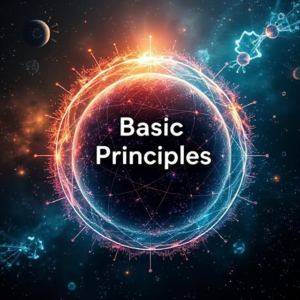The basic principles of physics are the fundamental concepts that explain how the physical world works. These principles help us understand everything around us, from the tiniest particles to the entire universe.

1. Newton’s Laws of Motion
These are three basic rules that describe how things move:
- First Law (Law of Inertia):
An object will stay at rest or keep moving at the same speed in a straight line unless acted on by a force.- Example: A ball will stay still unless you kick it or it’s hit by something.
- Second Law (F = ma):
The force acting on an object is equal to its mass times its acceleration. This means the heavier the object, the harder it is to move.- Example: It’s easier to push an empty shopping cart than a full one because the full one has more mass.
- Third Law (Action and Reaction):
For every action, there is an equal and opposite reaction.- Example: When you push a wall, the wall pushes back on you with the same force.
2. Conservation Laws
These are basic rules about certain quantities that don’t change in a system:
- Conservation of Energy:
Energy cannot be created or destroyed, only converted from one form to another (like from potential energy to kinetic energy).- Example: A roller coaster at the top of a hill has potential energy, but as it moves down, that energy turns into kinetic energy (motion).
- Conservation of Momentum:
The total momentum (mass × velocity) in an isolated system is constant.- Example: In a game of pool, when one ball hits another, the momentum is transferred, but the total momentum of the two balls combined stays the same.
3. Gravity
Gravity is the force that pulls objects toward each other. The more mass an object has, the stronger its gravitational pull.
- Example: Earth pulls everything towards its center, which is why things fall when you drop them.
4. Electromagnetism
This is the force that involves electric charges and magnetic fields. It explains how electricity and magnetism work together.
- Electricity:
Moving electric charges create electric fields and currents, which can power devices like lights and motors.- Example: A battery creates a flow of electrons, which powers a light bulb.
- Magnetism:
Moving electric charges also create magnetic fields. This is what makes magnets attract or repel each other.- Example: The magnetic field of Earth is what makes a compass point north.
5. Thermodynamics (Heat and Energy)
Thermodynamics is the study of heat and how energy moves between systems.
- First Law (Energy Conservation):
Energy can’t be created or destroyed, just transferred or changed from one form to another. - Second Law (Entropy):
In any energy transfer, some energy becomes unusable, often turning into heat. This leads to the idea of “entropy”—the measure of disorder in a system.- Example: A car engine gets hot because some of the energy from the fuel turns into heat, and that energy can’t be used to move the car.
- Third Law:
As the temperature of a system approaches absolute zero (the lowest possible temperature), the entropy of the system approaches a minimum.
6. Wave Theory
Waves are disturbances that carry energy. There are different types of waves, but they all share similar properties:
- Mechanical Waves:
These require a medium (like air, water, or solid objects) to travel through. Examples include sound waves and water waves.- Example: When you throw a rock into a pond, the ripples are waves.
- Electromagnetic Waves:
These do not require a medium and can travel through space. Light, radio waves, and X-rays are examples of electromagnetic waves.- Example: Light from the Sun travels through space and reaches Earth.
7. Relativity (Einstein’s Theory)
Albert Einstein’s theory of relativity changes how we think about space, time, and gravity:
- Special Relativity:
When things move close to the speed of light, time slows down for them, and objects appear shorter in the direction they’re moving.- Example: If you were traveling near the speed of light, you would age slower compared to someone on Earth.
- General Relativity:
Gravity isn’t just a force; it’s the bending of space and time by mass. Massive objects like planets or stars curve space-time around them, causing other objects to move towards them (what we experience as gravity).- Example: The Earth moves around the Sun because the Sun bends the space-time fabric around it.
8. Quantum Mechanics
This is the branch of physics that deals with the smallest particles, like atoms and subatomic particles (electrons, protons, etc.). It’s very different from classical physics:
- Particles and Waves:
Particles like electrons can behave both like particles and like waves, depending on how you look at them.- Example: Electrons can sometimes act like tiny balls, but other times they behave like ripples of energy.
- Uncertainty Principle:
It’s impossible to know both the exact position and the exact speed of a particle at the same time.- Example: You can know where an electron is most of the time, but you can’t know exactly where it is and how fast it’s going at the same time.
9. The Standard Model
The Standard Model of particle physics describes the fundamental particles and forces in the universe. It includes:
- Fermions: These are the basic building blocks of matter (like quarks and leptons, which make up atoms).
- Bosons: These are particles that mediate forces (like photons for electromagnetic force).
Conclusion:
These basic principles of physics help us understand everything from why objects fall to how the universe began. They cover a broad range of phenomena, from the motion of everyday objects to the behavior of tiny particles. Physics is all about uncovering the rules that govern the universe, helping us make sense of the world and even make technological advances.











